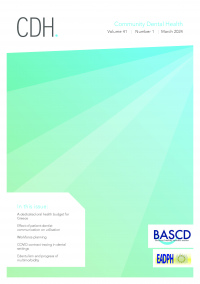Abstracts - Posters presented at the 14th Annual Congress of the European Association of Dental Public Health (EADPH) in Tromsö (Norway), September 3-5, 2009
Abstracts - Posters presented at the 14th Annual Congress of the European Association of Dental Public Health (EADPH) in Tromsö (Norway), September 3-5, 2009
Abstract
Session I: Diagnosis, treatment planning and disease prediction P1. Piloting s mutans plaque testing in 2-yearolds in Vantaa, Finland ARPALAHTI I1, SUNI J1, PIENIHÄKKINEN K2 City of Vantaa, Health and Social Welfare Affairs, 2University of Turku, Institute of Dentistry 1 P2. Decision authority among dentists from Denmark and Sweden BERTHELSEN H1, SÖDERFELDT B1, PEJTERSEN JH2, HJALMERS1 K, BERGSTRÖM1 K. 1 Department of Oral Public Health, Faculty of Odontology, Malmö University, Sweden;2National Research Centre for the Working Environment, Copenhagen, Denmark Aims In the health promotion project of Vantaa public health care a test for measuring plaque levels of mutans streptococci was launched in 2-year-old children. Calibration of the procedure and interpretation of bacterial growth was arranged for participants involved in the dental examinations of small children. The aim of the study was to obtain consistency in plaque testing and interpretation of bacterial growth among participants of different age, education and practical experience. Materials and Methods The training was organised in eleven day-care centres (between November 2007 and February 2008). The ethical committee of Helsinki gave approval for plaque testing. The parents of the children were asked for written permission. A total of 35 dental hygienists or dental nurses participated, in groups of 2–4. The trainees practiced the sampling and inoculation of plaque, as well as the interpretation of bacterial growth. A test on how to interpret the results and a structured questionnaire regarding the training were implemented. Results All trainees agreed or almost agreed to have gained practical benefit from the training and 92% of them considered the written instructions clear. However, less than 50% of trainees considered the interpretation of growth as easy. Agreement in the interpretation was highest in cases with no mutans streptococcal growth as well as in cases with abundant growth of bacteria. Conclusions Piloting plaque testing was aided by precise written instructions and practical education and training, which were carried out in collaboration with public day care centres. The training improved the quality and the consistency of the performance and gave each participant more certainty and confidence to use and interpret the bacterial tests. Sources of funding: State Provincial Office of Southern Finland. Aims Karasek and Theorell define job control as the worker’s control over work tasks and performance during the working day. The aim of this study was to analyse differences in job control, specifically decision authority, over aspects of the work of general dental practitioners from Denmark and Sweden. Materials and methods In 2008, a questionnaire was sent to 1,835 general dental practitioners, randomly selected from the dental associations in Sweden and Denmark (17% of the eligible population). The response rate was 68% after two reminders. Principal Components Analysis was applied to eight items about influence. Based on the resulting two factors, additive indices were established to measure decision authority: “influence on scheduling appointments” (2 items) and “general influence” (6 items). ANOVA with Tukey’s HSD test was used for comparison between groups based on nationality and sector for dentists with/without managerial responsibility. For analyses without equal variances, Kruskal-Wallis tests were applied. Results In both Denmark and Sweden, dentists from the public sector reported lower influence on scheduling appointments than private practitioners (p≤0.01). Comparing dentists from the same sector showed no significant differences between countries, neither after controlling for managerial responsibility. Dentists with managerial responsibility had higher influence than employed dentists (p≤0.001). For dentists without leadership tasks, similar patterns were seen. In contrast, Swedish dentists with managerial responsibility reported higher general influence than their Danish colleagues (p≤0.01). Independently of gender and nationality, private managers had higher general influence than their public counterparts (p≤0.01). Dentists with managerial responsibility had higher influence than employed dentists (p≤0.001). Conclusions Differences in decision authority were found between general dental practitioners working in the public and the private sector in both countries. The results may reflect different management cultures as well as different structural organization of the work. The authors wish to acknowledge the Swedish Council for Working Life and Social Research, Malmö University and The Danish Dental Association for financial support.




